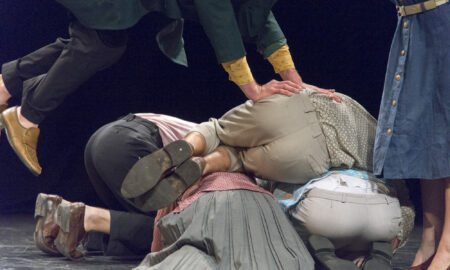On February 8, two performances in the Premiere program were unfolding at the stage of Sõltumatu Tantsu Lava: Sanghoon Lee’s ‘It Is Still Impossible To Exist At Two Places At Once’ and Grėtė Šmitaitė’s ‘What Do I Cry For?’.
Sanghoon Lee with his objects on the stage (kettles, vacuum cleaner, ladder) reminds me of Sigrid Savi’s Premiere 2018 production ‘Imagine There´s a Fish’. Sensing the space through objects becomes discovering humanness or our material culture. There is something cute in how we smoke or eat potato chips or walk around, face covered with Christmas tinsel, or stand beside a speaker that is swinging like a pendulum. We? Or they – Karolin Poska and Sanghoon Lee.
The lack of music and the use of objects to produce sound leads to discovering the ambiance. Smells, movements that are associated with odours; sounds that are associated with reflexes that are, in a way, specific to being sociable like smoking near something warm. At times, Sanghoon Lee ironically resembles the rules in a quiet, somewhat remote way. The rules of a smoking room or potato chips come to mind, i.e. that neither smoke nor processed food is not beneficial. The question remains, of course, whether everything that a person consumes must always be beneficial. Funny, absurd rules from people to people. Karolin Poska helps Sanghoon Lee to implement the parallelism of breaking the rules.
Since all these violations of rules have been carried out politely and joyfully then you feel like giggling. It’s a bit like watching a little next-door boy stealing apples for the first time. He’s a very cute boy. Acting real sweet. So what, that he is stealing apples from the next-door auntie. But he doesn’t hurt anyone! It’s cute how he steals. Like the smoking of Poska and Lee. It’s cute. Together they look a bit like Moomins. Beautiful and funny.

But the mood is changing during the performance of Grėtė Šmitaitė. It’s inconvenient. It’s weird. I’m not even sure what Šmitaitė is doing. From behind the dancer-choreographer looks like a boy in a feather jacket who is dancing in club Hollywood, has accidentally lost his trousers and is now cheeping like a tiny black chick in the middle of cobblestones, looking for his mother hen or a girl who is the reason why he is dancing there in the first place. But who is not there, is a mother hen or that girl. Black swan in the modern take of ‘Swan Lake’, I state a few moments later, especially when I hear the Lithuanian disco music.
Inevitably, I start to compare the dance of sadness with Stella Kruusamägi’s ‘Holy Rage’ that I saw at Püha Vaimu SAAL of Kanuti Gildi SAAL. Kruusamägi radiates sharp precise rage. Sadness is more complicated. It is not so easily danceable. Šmitaitė’s sadness does not get under my skin, it gets stuck in the feathers falling on the floor, in a smile that is not confident but is confident at the same time. It’s like the question itself: “What do I cry for?”. There’s something absurd in this question. A person finds oneself crying and does not know why they are crying. Šmitaitė has an uncanny impact. This creates a different kind of rage than Stella Kruusamägi’s holy rage. Grėtė Šmitaitė does not directly move her audience in a way Stella Kruusamägi did with her performance. She is approaching the sadness indirectly.
Sadness does not have to be a tragic feeling that forces one against the ground. It may be related to melancholy, an encounter with one’s boundedness, limitations. And then — at the end of the day, the black chick will understand that one can smile, calmly, expectantly, as Grėtė Šmitaitė does. Carefully. It is a bit like a smile of Sanghoon Lee and Karolin Poska. There’s some irony squeezed in there.
Neither one of the performances struck me. But I would be really struck if someone who is fascinated by the Conservative People’s Party of Estonia saw the last scene of Sanghoon Lee’s show, even if by accident, and would be offended because — who wears the pants here? A woman or a man? This unfortunate person would also be struck by the androgyny of Grėtė Šmitaitė. Fortunately, or unfortunately, I don’t see that kind of people at Sõltumatu Tantsu Lava and among the audience, because they wouldn’t stand the haziness, half-tones. Half-sadness. Although it exists in the world around us. And that’s why it is sometimes worth to think about what we really are or why we are crying.
For further information about the upcoming performances, click here: http://kultuur.info/event/premiere19-what-do-i-cry-for-and-it-is-still-impossible-to-exist-at-two-places-at-once/

